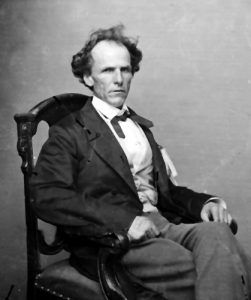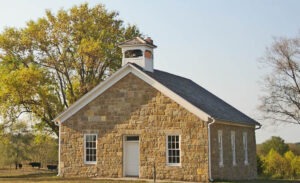
James Lane
Lanesfield, Kansas, in Johnson County, was a Free-State town located on the Santa Fe Trail. The town no longer exists today.
A post office, named Hibbard, was established in 1855 in the area.
In August 1856, a group of pro-slavery forces from Missouri came into Kansas and settled on the bank of Bull Creek. However, when James H. Lane, a Free-State leader, heard this news, he was determined to drive them out of the state. On September 1, 1856, Lane mustered a group of a few hundred men from Lawrence and Topeka to confront a pro-slavery force of 1,600 fighters who were camped out at Bull Creek. When the men arrived, Lane realized he was greatly outnumbered and devised a plan to deceive the opposing forces. From a distance, he positioned and paraded his men in such a way that the pro-slavery Missourians believed Lane’s forces were larger. After a brief skirmish, where only a few shots were fired, the Missourians retreated 30 miles back to Westport, Missouri. After the men left, Lane ordered that the cabin of Richard McCamish, a pro-slavery supporter who owned the land where the battle was fought, be burned. Called the Battle of Bull Creek, this victory made Lane a hero and cemented his reputation in the Kansas Territory.
In 1858, William Gans, who came from Indiana, chose a beautiful 160 acre stretch of land on which to settle on the west side of Bull Creek. The same year, he established a small town on his property that was named for his friend and anti-slavery defender James Lane. The original plat was ambitious, including 40 blocks, some with 25 lots.
Co-founding the town, Lane personally oversaw the construction of a hotel, three stores, a blacksmith shop, three churches, and some residential houses in the town. In the early years, Lanesfield grew to reach about 100 people.
Located along the Santa Fe Trail, the trail traffic formed a major part of the town’s identity. The trail was regularly frequented by merchants, traders, soldiers, trappers, missionaries, and farmers. Lanesfield received monthly mail from stagecoaches traveling between Westport, Missouri, and Santa Fe, New Mexico, and connected the small town to a broader view of cultural and commercial exchange.
Unfortunately, Lanesfield was established during the “Bleeding Kansas” days when Missourians and Kansans fought over whether Kansas would become a slave-state or a Free-State. When the Kansas-Nebraska Act of 1854 opened Kansas Territory to settlement and eventual statehood, it allowed residents to decide the issue of slavery. The six-year struggle for control of Kansas Territory turned into a vicious and bloody border war that raged between New England abolitionists who settled the territory to be a “free state” and Missourians who crossed the border to support slavery.
In 1863, William C. Quantrill led 450 men through Kansas to Lawrence on a path that went through the Lanesfield area. About 150 people died, 30 more wounded, and around 200 homes were destroyed in the Lawrence Massacre on August 21, 1863.
In the meantime, a Presbyterian congregation was established in June 1860. On July 17, 1861, the Hibbard post office was moved to Lanesfield. It then became a mail stop on the Santa Fe Trail. The first school was convened in 1863 a the home of William Gans.
Lanesfield survived the political upheaval of the Civil War and the and Santa Fe Trail traffic continued for several more years.
By 1867, 18 students attended class in a log schoolhouse on the Burton Dillie farm. In 1868, the Presbyterians built a church.
In May 1869, the townsmen issued $1000 worth of school bonds and the Lanesfield one-room schoolhouse began to be built. In the spring of 1870, 69 students enrolled at the school but the average attendance was 51. Students from the school noted that they could see travelers on the trail from their schoolhouse window. The school also served as a community meeting place and polling station.
The town dramatically declined when the Atchison, Topeka & Santa Fe Railroad was built through nearby Edgerton, instead of Lanesfield, in 1870. As a result, most of the residents in Lanesfield moved their homes and businesses to Edgerton. The Lanesfield post office closed on September 16, 1870. The Presbyterian Church and the blacksmith shop moved to Edgerton in 1871.
By 1872, all that remained in Lanesfield was the hotel, the school, and a few houses.
On July 5, 1883, The Johnson County Democrat reported Lanesfield as a “defunct city where the Old Santa Fe Trail crosses Bull Creek.”
Enrollment in Lanesfield’s one-room schoolhouse began to decline in the late 1950s. After 93 years of operation, the rural school closed in 1963.
The school is the only building left in what was once the town of Lanesfield.
Preserved today, the limestone building is the oldest operating schoolhouse in Johnson County. It became a museum in 1967 and was listed on the National Register of Historic Places in 1988. The site today includes the original schoolhouse, four outbuildings, and a visitors center that houses an exhibit room, a museum store, and restrooms. Admission is free. It is located at 18745 Dillie Road, Edgerton, Kansas.
Lanesfield was located two miles northeast of Edgerton, Kansas.
©Kathy Alexander/Legends of Kansas, January 2022.
Also See:
Kansas Ghost Town Photo Galleries
Sources:
Angles, Steven; Lanesfield, Johnson County, Lost Kansas Communities, Chapman Center for Rural Studies, Kansas State University, 2012
Cutler, William G; History of Kansas; A. T. Andreas, Chicago, IL, 1883.
Johnson County History
National Register of Historic Places
Steed, Laura; Ghost towns of Johnson County, 1973, unknown publisher


